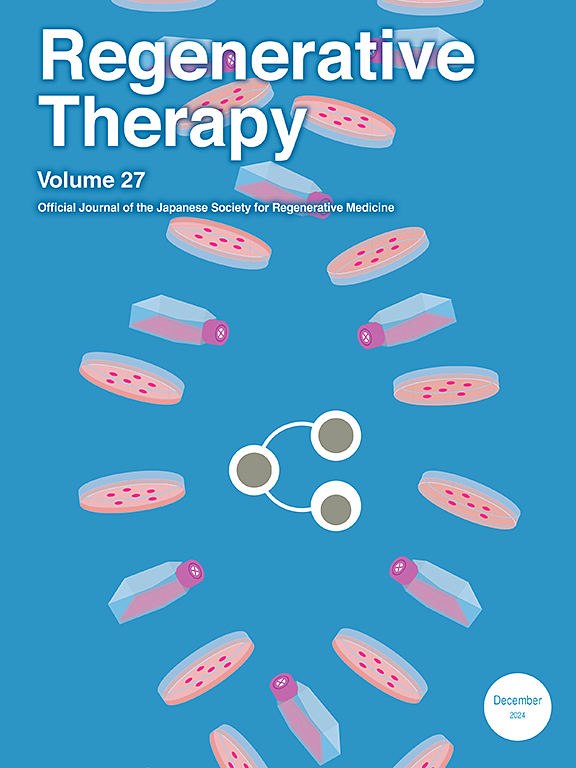Human growth hormone-overexpressing adipose-derived stem cells enhance fibroblast activity and accelerate burn wound healing via ERK pathway therapeutic potential of ADSCs in burn wound repair
IF 3.5
3区 环境科学与生态学
Q3 CELL & TISSUE ENGINEERING
引用次数: 0
Abstract
Objective
Human growth hormone (HGH) enhances wound healing by promoting cell proliferation, angiogenesis, and tissue regeneration. This study investigated the effects of HGH-overexpressing Adipose-derived stem cells (HGH-ADSCs) on fibroblast function, ERK pathway activation, and burn wound healing.
Methods
ADSCs were isolated from adipose tissue, characterized via CD marker expression, and confirmed for multipotency using Oil Red O (adipogenesis), Alizarin Red S (osteogenesis), and Alcian Blue staining (chondrogenesis). ADSCs were then transduced with a lentiviral vector carrying HGH, generating HGH-ADSCs and confirmed by qRT-PCR. Fibroblasts (HDF-a) were co-cultured were co-cultured under HGH-ADSCs-conditioned medium and ADSCs-conditioned medium to assess proliferation (MTT assay), migration and invasion (Transwell), apoptosis (flow cytometry), and G0/G1 cell cycle progression. Western blotting determined ERK activation, and SCH772984 (ERK inhibitor) was used to confirm pathway dependency. A burn rat model was established with three treatment groups: HGH-ADSCs, ADSCs, and saline. and histopathology (H&E, TUNEL staining) analyzed epithelial regeneration and apoptosis. ELISA and biochemical assays quantified TNF-α, IL-1β, IL-6, MDA, SOD, and CAT in wound tissue homogenates.
Results
HGH-ADSCs significantly enhanced fibroblast proliferation, migration, invasion, and prolonged G0/G1 phase while reducing apoptosis (P < 0.05). ERK inhibition abolished these effects (P < 0.05). In vivo, HGH-ADSCs accelerated wound closure (P < 0.05), enhanced epithelialization, reduced inflammation, and increased collagen formation. Inflammatory cytokines (TNF-α, IL-1β, IL-6) and MDA were lowest, while SOD and CAT were highest in HGH-ADSC-treated wounds (P < 0.05).
Conclusion
ADSCs overexpressing HGH promote fibroblast activity, activate ERK signaling, and accelerate burn wound healing, demonstrating strong therapeutic potential.
过度表达人类生长激素的脂肪源性干细胞通过ERK通路增强成纤维细胞活性并加速烧伤创面愈合
目的:人生长激素(HGH)通过促进细胞增殖、血管生成和组织再生来促进伤口愈合。本研究探讨了过表达hgh的脂肪源性干细胞(HGH-ADSCs)对成纤维细胞功能、ERK通路激活和烧伤创面愈合的影响。方法从脂肪组织中分离sadscs,通过CD标记表达进行鉴定,并通过油红O(脂肪形成)、茜素红S(成骨)和阿利新蓝染色(软骨形成)证实其多能性。然后用携带HGH的慢病毒载体转导ADSCs,生成HGH-ADSCs,并通过qRT-PCR证实。成纤维细胞(HDF-a)在hgh - adscs条件培养基和adscs条件培养基中共培养,以评估增殖(MTT试验)、迁移和侵袭(Transwell)、凋亡(流式细胞术)和G0/G1细胞周期进展。Western blotting检测ERK活化,SCH772984 (ERK抑制剂)检测通路依赖性。采用HGH-ADSCs、ADSCs、生理盐水三组治疗大鼠烧伤模型。组织病理学(H&;E, TUNEL染色)分析上皮再生和凋亡。ELISA和生化分析定量了伤口组织匀浆中的TNF-α、IL-1β、IL-6、MDA、SOD和CAT。结果shgh - adscs显著增强成纤维细胞增殖、迁移、侵袭,延长G0/G1期,减少细胞凋亡(P <;0.05)。ERK抑制消除了这些影响(P <;0.05)。在体内,HGH-ADSCs加速伤口愈合(P <;0.05),上皮化增强,炎症减少,胶原形成增加。炎症因子(TNF-α, IL-1β, IL-6)和MDA在hgh - adsc处理的伤口中最低,SOD和CAT在hgh - adsc处理的伤口中最高(P <;0.05)。结论过表达HGH的adscs促进成纤维细胞活性,激活ERK信号,促进烧伤创面愈合,具有较强的治疗潜力。
本文章由计算机程序翻译,如有差异,请以英文原文为准。
求助全文
约1分钟内获得全文
求助全文
来源期刊

Regenerative Therapy
Engineering-Biomedical Engineering
CiteScore
6.00
自引率
2.30%
发文量
106
审稿时长
49 days
期刊介绍:
Regenerative Therapy is the official peer-reviewed online journal of the Japanese Society for Regenerative Medicine.
Regenerative Therapy is a multidisciplinary journal that publishes original articles and reviews of basic research, clinical translation, industrial development, and regulatory issues focusing on stem cell biology, tissue engineering, and regenerative medicine.
 求助内容:
求助内容: 应助结果提醒方式:
应助结果提醒方式:


